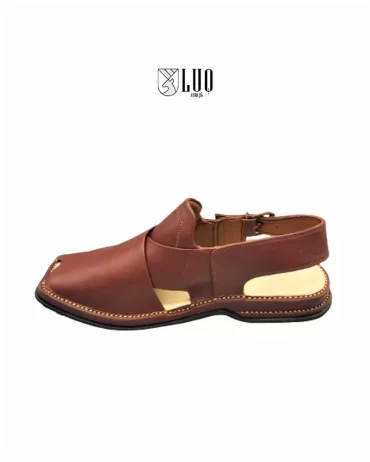Uncategorized
Discover the History and Craft of Distinctive Charsadda Chappals of Pakistan
Charsadda Chappals of Pakistan
The handmade leather Charsadda chappal is a type of traditional footwear that originates from the Charsadda district in Khyber Pakhtunkhwa province of Pakistan. These chappals have a distinctive style and design that set them apart from regular sandals or flip-flops.
The craft of making these traditional Charsadda chappals has been passed down through generations and provides livelihoods for many skilled artisans in the region.
History and Significance of Charsadda Chappal
The history of Charsadda chappal making goes back 300 years as per some accounts . The chappal gets its name from the Charsadda city, which has been a hub for handicrafts including footwear for ages. These chappals became popular due to their unique pointed curl-up toe design along with skilled handcrafting using quality leather.
As per 2018 estimates, the chappal trade employed over 30,000 people and had an annual turnover of Rs. 3 billion in Charsadda district alone .
The Charsadda chappal is significant because it represents the rich cultural heritage of Pakistan. It highlights local artisanal skills in leather crafting as the chappals are entirely handmade and decorated with stitching, sequins, and studs. The light and breathable design offer comfort in hot climates while the distinctive style reflecting Central Asian and Mughal influences give it fashion appeal globally.
Raw Materials and Making Process
The key raw materials used are good quality leather hides along with accessories for stitching and decorations. The artisans procure cow or buffalo hide locally and treat it to produce strong yet soft leather perfect for crafting chappals . The hide undergoes an extensive tanning and coloring process using natural ingredients like lemon juice, oil, dye, etc. to achieve the desired suppleness and tone.
The chappal making process involves cutting the shaped outsole pieces from tanned leather by hand. The skilled craftsmen assemble the pieces using both stitching as well as durable bovine glue. Decoration using sequin pieces, beads, cowry shells, mirrored pieces etc. is also done by hand requiring painstaking effort .
The chappals may have embroidered patterns on the joining straps for further ornamentation. Finally, the finished chappal is polished and given a protective coating to increase longevity. It takes 2-3 days to handcraft a pair of high-quality Charsadda chappals.
Distinctive Styling and Design Elements
The Charsadda chappals stand due to several unique design elements:
Pointed Curled Toes: The signature feature is the upward curling pointed toe giving it a distinct silhouette. This prevents slipping and aids grip, especially when worn with shalwar kameez dress.
Low Heel Strap: The single strap across the heel is uniform without any gap to perfectly fit most foot sizes for men and women.
Ornamentation: Hand embroidery with thread and mirror work along the strap along with sequins, cowries, beads, wires etc. decoration make each pair a handicraft masterpiece.
Vibrant Colors: From deep burgundy and brown to multi-hued designs, the chappals come in various colors reflecting the rich crafting traditions of South Asia.
Ranges and Varieties
Over the centuries, the Charsadda chappals have evolved into different ranges to suit modern needs:
Classic Khussa: The signature style features pointed curling toes with decorative stitching and single heel straps in various colors.
Embroidered: More ornate with intricate floral patterns and traditional motifs in thread, sequin, beads etc.
Casual: Contemporary minimal designs focusing on utility with flats, and sneaker styles as well for younger buyers.
Bridal: Luxurious designs encrusted with semi-precious stones, cowries shells, and intricate patterns using silk threads perfect as wedding footwear.
Themes like Moroccan-inspired patterns using vibrant colors and fabrics like velvet have also emerged. Innovation continues keeping skills alive by making bespoke chappals part of modern footwear wardrobes.
Current Centres of Production
While small clusters exist countrywide, Charsadda city in KP province continues to be the prime production centre for these namesake chappals catering to domestic demand as well as exports . Cottage industries employ master craftsmen who handmake the chappals using traditional methods.
Prominent manufacturing bases include Doaba Haji Abdul Majid, Doaba Al-Hasan, and Doaba Usman Ghani villages which support over 300 shoe making units . The high-quality craftsmanship has established Charsadda as the ‘shoe capital’ of Pakistan exporting around $5 million worth of handcrafted chappals annually. Aside from retail shops nationwide, leading e-commerce portals have widened distribution globally.
Conclusion
The handcrafted Charsadda chappal represents the diverse artisanal heritage of Pakistan passed across generations while providing livelihoods to thousands.
The global popularity of these chappals embellished with sequin patterns and pointed curling toes highlights the rich culture. Supporting the skilled rural artisans keeping the traditional craft alive is also significant from an economic viewpoint.
The Charsadda chappal offers utility and style while being eco-friendly and sustainable when produced using traditional tanning methods. From traditional khussa to contemporary designs, it continues to be a fashionable eco-friendly footwear representing Pakistan worldwide.

